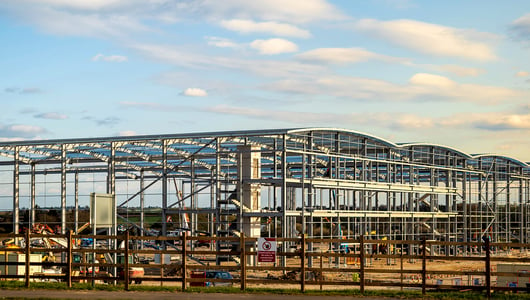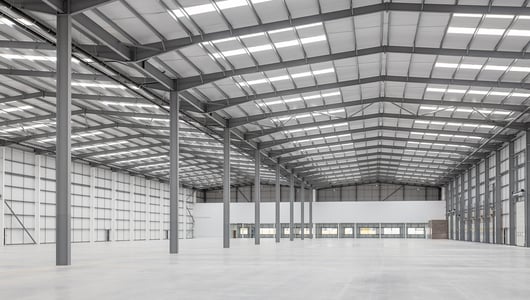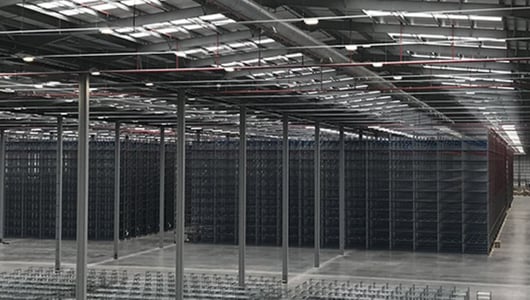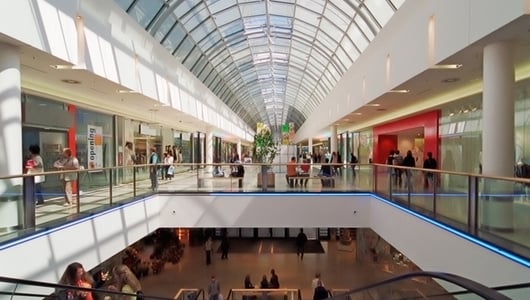Commercial market update Q1 2023

The bond vs property yield spread ticked up in Q4 but remains nearly the narrowest in a decade.
The yield spread bounced back slightly towards the end of the year as gilt yields fell back as the political landscape became more stable but remains close to the low at the end of last year, which was at a level not registered since the GFC of 2008/9. Property yields continued to climb in Q4 as the sector re-priced to absorb higher borrowing costs. The next 18-24 months will all be about income returns and seeking to minimise any capital depreciation.
Offices: Two tier market continues. Enticing workers back to offices and the desire among businesses to ensure their buildings fit with their ESG aims means that the two-tier office market continues, especially in London. The net absorption of prime London offices has been positive all through the pandemic, while poorer quality stock has registered -10m sq ft of negative net absorption. While office take-up across the UK hit a four-year high in November, overall net absorption remained negative as more space was delivered. There is a full pipeline for delivery meaning vacancy rates will rise this year.
Retail: Some stabilisation ahead. The pick-up in footfall as lockdown ended, which provided a boost to this sector which was deeply affected by the pandemic, will now be challenged by the cost-of-living crisis and economic headwinds. But in markets where re-pricing has already happened, this may provide the basis for more stable conditions ahead. Yields continued to soften in Q4 , across retail especially impacting supermarket capital values which declined by -16.3% over the quarter. Business rates changes coming into force in April will provide a fillip for the sector.
Industrial: Strong demand remains. After a bumper few years during the pandemic when rents and values climbed sharply, the market saw a dramatic price correction in the second half of 2022. Demand remains strong and supply is constrained in some areas, which put a floor under rents. But the increased cost of borrowing and the cloudier economic outlook resulted in a softening of yields which continued in Q4, up 1.3 percentage points since the summer, but still at levels last seen in May 2020.
Economy: The picture is brighter than October, but the era of ultra-low base rates is over. The Bank of England raised rates to 4% in February, and while there is some disagreement if another rise is on the cards imminently, there is broad agreement that the 10 or so interest rates rises seen over the last 12 months will not be unwound in the near future. We may see rates peak and start to fall back later this year or in 2024, but borrowing costs are set to remain elevated in the medium term, creating more opportunities for cash investors. There is more detail in our latest economic outlook.
Development: Change of use and build costs top of mind. As proposed new rules on EPC ratings move closer, the increased cost of refurbishment – given the sharp inflationary pressures of the last year – will be top of mind for landlords and developers. Where investment is being made, developers and landlords are increasingly looking at change of use, alongside other asset management initiatives.


The information provided in this report is the sole property of Cluttons LLP and provides basic information and not legal advice. It must not be copied, reproduced or transmitted in any form or by any means, either in whole or in part, without the prior written consent of Cluttons LLP. The information contained in this report has been obtained from sources generally regarded to be reliable. However, no representation is made, or warranty given, in respect of the accuracy of this information. Cluttons LLP does not accept any liability in negligence or otherwise for any loss or damage suffered by any party resulting from reliance on this publication.
Related research

Office market update Spring 2024
The structural change in the office market is ongoing, with strong appetite for best-in-class office space which meets high net-zero requirements and insipid demand for secondary or tertiary space. The investment market was quiet overall in 2023, although some notable deals were struck where pricing was competitive.
Retail market update Spring 2024
Take-up rose towards the end of 2023, but overall vacancy rates are flattered by the lack of supply in the market. The bright spot for landlords is luxury retail and retail parks, where consumer demand is still relatively stronger.
Industrial market update Spring 2024
Vacancy rates creep up and rents ease. The recalibration of the Industrial market after the pandemic uplift continues, but overall, the sector continues to outperform compared to other asset classes.
Commercial market update Winter 2023
The Bank of England’s decision to keep the base rate on hold at 5.25% for the second consecutive time in November has raised the prospect that interest rates are at their peak.
Office market update Winter 2023
Flight to quality continues. There has never been such a distinct divergence between prime and secondary property, and this is still being driven by companies adjusting to changing working patterns as well as a desire to meet higher net-zero targets.
Industrial market update Winter 2023
Slowing rental growth. Robust occupational market conditions amid tight supply are helping to maintain a continued confidence after significant repricing in the sector.
Retail market update Winter 2023
Slowing market. Prime high street assets are among the best performing within retail – these assets have stabilised and there is opportunity for future rental growth where values have been rebased.
Commercial market update Autumn 2023
Will they? Won’t they? This is the key question around whether the UK’s base rate will exceed 5.75%. There have been enough mixed messages to muddy the waters – inflation data released in June showed that inflation was stuck at 8.7% in May, which prompted forecasts that the base rate would peak at 6.5% from the current rate of 5.25%.
Office market update Autumn 2023
UK office vacancy rate continues to climb. Weak demand and strong supply are resulting in an ever-rising vacancy rate for offices across the UK, which has hit 7.7%, up from less than 5% before the pandemic.
Retail market update Autumn 2023
The retail environment remains challenging. The rising cost of living, and recent disappointing weather have led to a further tick down in overall sales.
Industrial market update Autumn 2023
Vacancy rate remains low. Net absorption of industrial space dipped into negative territory in Q2 2023 for the first time in 11 years as take up fell back to levels last seen before the pandemic.
Commercial market update Q2 2023
The UK’s economic mood music has been more upbeat so far this year than many would have anticipated in the wake of the mini-budget last year. This culminated in the IMF, traditionally circumspect about the UK’s economic outlook, confirming in late May that the country would not enter recession this year, contrary to its earlier forecasts.
Office market update Q2 2023
Office take-up gained some momentum towards the end of Q1 as employees continue to return to the workplace in greater numbers. But overall demand for office space remains muted compared to historical norms.
Retail market update Q2 2023
Retail sales fell back in May after rising slightly in April, according to a survey from the CBI, but the overall outlook is slightly more upbeat than at the beginning of the year as consumer confidence continues to climb and the prospect of lower energy bills is factored in.
Industrial market update Q2 2023
Average industrial property yields, according to MSCI, which softened sharply last year remained largely unchanged in Q1 2023, as the market absorbed the new economic landscape in the UK.
UK economic outlook Q2 2023
Higher than expected inflation dampens expectations for UK economy. Inflation data was higher than expected in May, which has weighed on business confidence, and has pushed interest rate expectations, and the cost of borrowing, higher.
Retail market update Q1 2023
Retail sales ticked up slightly in January but are still down on a three-monthly basis from the post-pandemic highs in the summer of 2021.
Industrial market update Q1 2023
The strong performance in this sector over the last few years mean that the upheaval caused by rising interest rates and the September’s mini-budget, which caused a surge in gilt yields, was more pronounced than other sectors.
Office market update Q1 2023
UK office vacancy rate rises, but masks a two-tier market.
UK economic outlook Q1 2023
The economic outlook for the UK is challenging this year, but there is growing consensus that the downturn will not be as long as previously expected.
UK office leasing review Q2 2020
Coronavirus leads to dramatic declines in leasing activity.
UK office investment review Q2 2020
Transaction volumes decline during lockdown.
UK industrial & distribution review Q2 2020
Transaction volumes declined during lockdown, with investment into distribution most favoured.
UK retail investment review Q2 2020
Retail investment market shuts down during the COVID-19 lockdown.

